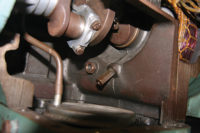One of the more popular electrical services that is supplied to medium-size commercial buildings is the Wye or Star configuration. The name comes from the transformer’s secondary winding configuration, which looks like a ‘Y’ or three-sided star (Figure 1). This dual voltage, three-phase electrical service usually delivers four wires to the building.
There are actually three 120-V windings in the secondary of the step-down transformer that are 120 degrees apart. They consist of three hot wires and a neutral or ground. The secondary winding of the Wye is center-tapped and grounded. This makes the center tap perfectly symmetrical to all three phases of its power.
Voltages
Wye service can be used for three-phase or single-phase applications. Single-phase voltages can be picked off of the Wye secondary (Figure 2). Listed here are those single-phase voltages:
A to B — 208 V
A to C — 208 V
B to C — 208 V
A to N — 120 V
B to N — 120 V
C to N — 120 V
As we can see, 120-V single-phase, 208-V single-phase, and 208-V three-phase power can be had from the Wye when it is center tapped to the ground. The 208-V three-phase happens when all three leads are used (A, B, and C).
Remember, voltage is only measured relative to any two of the leads, though. Also, if the Wye was not center-tapped to ground, no low-voltage (120-V) single-phase power would be available. However, 208-V single-phase and 208-V three-phase power still would be available without the center-tap. The 208-V single-phase power would come from any two power legs — A and B, B and C, or A and C.
It can be said that any two of the three windings of the Wye secondary are in series with one another. However, remember that power surges of the induced voltages that come from the primary windings of the transformer to the secondary windings are not in phase with one another.
In fact, each phase is 120 degrees out of phase with one another (Figure 3). When one phase is positive and maximum voltage, the voltages of the other phases or windings may be negative and less than maximum. This phenomenon makes the voltage between any two conductors to be 208 V and not 240 V (120 V x 2).
Loads
Notice that the neutral or ground wire is connected to the center of the Wye, which makes it perfectly symmetrical to all three windings. The voltage between any phase (A, B, or C) and neutral (N) will be 120 V.
All 120-V single-phase loads may be connected to neutral and any of the three power-phase wires, A, B, or C, without worrying about burning them out from too high of a voltage. To balance the electrical loads, all single-phase loads should be equally spread between the three secondary windings.
Higher Voltages
If the turns of wire of the secondary windings are increased, a higher voltage will be induced into them from the primary windings of the service transformer. Often, each phase of the Wye transformer to neutral will deliver 277 V instead of 120, and the voltage between any two phases is 480 V instead of 208. The 277 V is often used for lighting in commercial and industrial buildings.
The advantage of the higher voltage is to reduce the amperage for a given amount of power. Line losses are reduced and wiring size can now be reduced because of the lower amperage flow. Even electric motors can be made lighter because of the higher voltage causing a smaller wire size.
Publication date: 2/3/2014
Want more HVAC industry news and information? Join The NEWS on Facebook, Twitter, and LinkedIn today!













